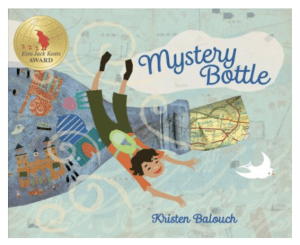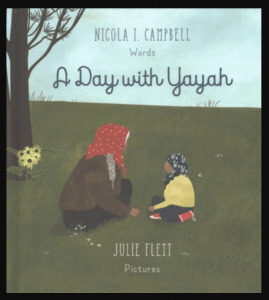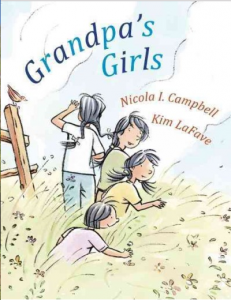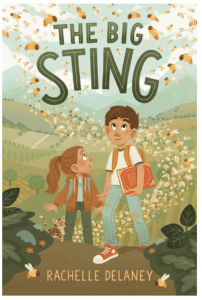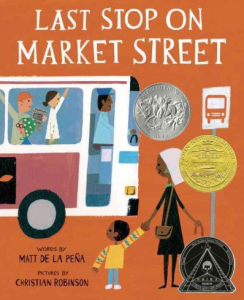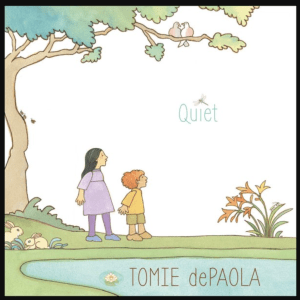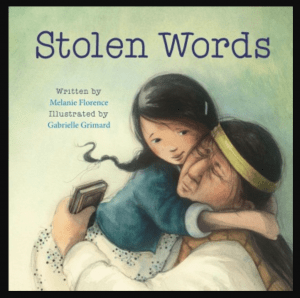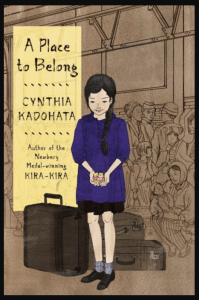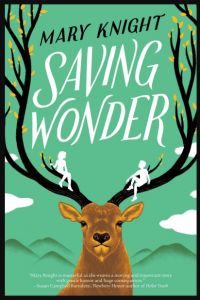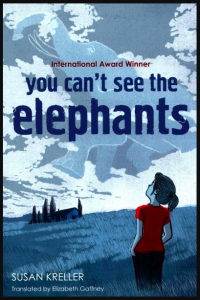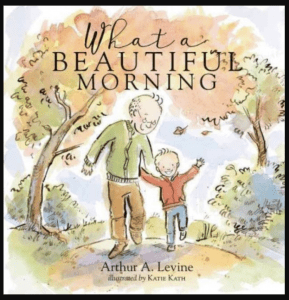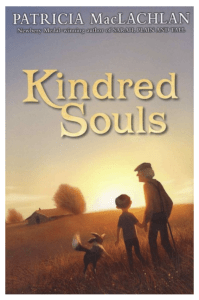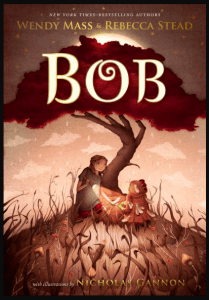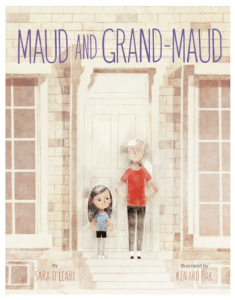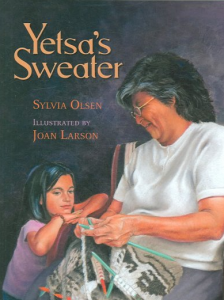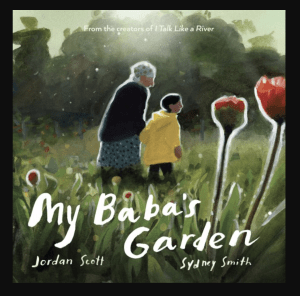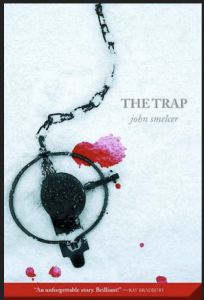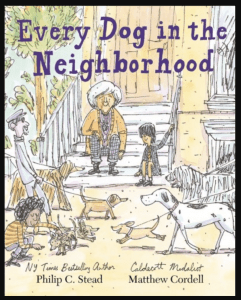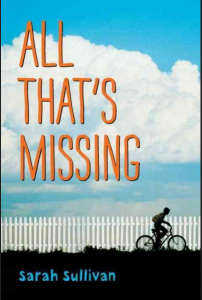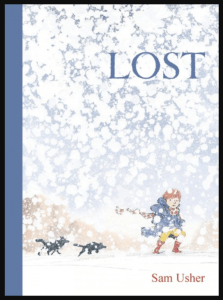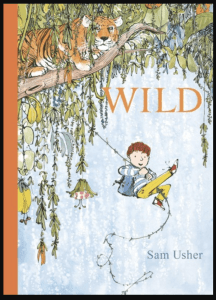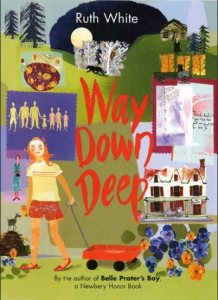Balouch, Kristen. Mystery Bottle. Northampton, MA: Crocodile Books, an imprint of Interlink Publishing Group, Inc., 2022.
What do you own that reminds you of another place, another person, another time? A boy in New York opens a package from Iran. Inside is a little bottle. And out of that bottle comes a wind that carries him from Brooklyn all the way to Tehran and into the arms of his loving grandfather. This beautifully designed picture book, a winner of the Ezra Jack Keats Award, is highly recommended for imaginative readers 5 to 9 years old.
Campbell, Nicola I. A Day with Yayah. Vancouver: Tradewind Books, 2017.
Nikki and her loving grandmother set out to spend the day gathering plants out on the land. Jamesie, Lenny, Grand-auntie Susan and Grand-uncle Chester join them as they search for wild rhubarb and potatoes, wild celery and sunflowers, and golden brown lightning mushrooms. Giving thanks to the Creator for the gift of food, they collect their discoveries and settle down for a picnic of salmon sandwiches and hot sweet tea. Set in the Nicola Valley of British Columbia, this heart-warming story illustrated by Julie Flett is made more powerful by the inclusion of words from the Nłeʔkepmxcin language. A glossary at the end provides both definitions and a pronunciation guide, and an afterward provides information about this Interior Salishan group of indigenous people. Most highly recommended for readers of all ages.
Campbell, Nicola. Granpa’s Girls. Toronto: Groundwood Books, 2011.
Gentle illustrations by Kim LaFaye accompany this story of a young girl’s loving relationship with her grandfather and her adventures on his farm. Dedicated to her own grandfather, an aboriginal war veteran of WW2, Campbell has written a happy story based on memories of her own childhood. A few words in the language of the Interior Salish people are smoothly inserted into this picture book, making it all the more realistic and endearing. Highly recommended for all readers and prospective storytellers 7-years-old and up. [Farm life; Veterans]
Delaney, Rachelle. The Big Sting. Toronto: Tundra, 2023.
Leo and his family are spending a week on a small island off the coast of British Columbia. Leo enjoys virtual adventures on his computer at home in Toronto, but now he is in the middle of a real-life mystery: his recently deceased grandmother’s beehives have been stolen and his grandfather is determined to find them. Meanwhile, his parents have taken themselves off to a luxury resort. How will Leo cope with his grumpy grandfather and impetuous younger sister? The hopefulness of Patricia MacLachlan’s stories and the zany humour of Polly Horvath’s stories combine in this life-affirming novel highly recommended for readers 8 to 11 years old.
de la Peña, Matt. Last Stop on Market Street. New York: G.P. Putnam’s Sons, 2015.
“A young boy rides the bus across town with his grandmother and learns to appreciate the beauty in everyday things.” – CIP. “Sometimes when you’re surrounded by dirt…you’re a better witness for what’s beautiful.” [Buses; City and town life; Grandmothers]
dePaola, Tomie. Quiet. New York: Simon & Schuster Books for Young Readers, 2018.
“Hurry up! Be quick!” Sometimes it seems every day is filled with “Can’t you go faster?” What about being quiet and still? What about observing? What about taking time to sit and think? In this peaceful picture book, a grandfather takes two grandchildren on a walk and shows them how nature is sometimes busy and sometimes still. The simple calm green text and soft pastel-coloured illustrations combine to create a timeless reminder for all ages.
Florence, Melanie. Stolen Words. Toronto: Second Story Press, 2017.
What did you call your grandfather when you were very young? Grandpa? Opa? Papi? Baba? How does hearing the words of your early childhood affect your memories? Your emotions?
A little girl asks her grandfather what to call him in Cree. He doesn’t know. He was sent to residential school when he was young and his language was taken away. So she goes to her school library and comes home with a book: Introduction to Cree. Together, they learn the language of their culture. This gently powerful picture book – illustrated by Gabrielle Grimard – is highly recommended for readers of all ages.
Kadohata, Cynthia. A Place to Belong. New York: Atheneum, 2019.
Twelve-year-old Hanako, her younger brother, and her parents have been incarcerated in internment camps ever since the bombing of Pearl Harbor in 1942. Although the war is now over, her family is still not wanted in America, so her parents give up their American citizenship and move to Japan. Her grandparents are overjoyed to see them, but Hanako doesn’t feel at home. She is too American to blend into Japanese life. And the poverty is overwhelming.
This 399-page novel is an outstanding addition to the historical fiction genre. The facts of post-war Japanese life are smoothly embedded in an emotionally powerful story – with an unerring sense of voice – highly recommended for competent readers 11 years old and up.
P.S. This is a superb novel for a small group study. Numerous thought-provoking sentences will promote connections between the story and readers’ own lives…
“‘When I walked away last time…I never looked back….I was scared it would make me change my mind’” (90).
“‘…you must forgive….I see and hear many bad in world, many bad….but there is also many good. So we move forward in life, neh? When we can, we move forward’” (105).
“This was the thing about being spoiled: you had to rise above it” (136).
“There was not enough; this was a fact. The world was filled with facts that could not be changed. She had learned this during their camp days. There were many, many, many facts” (158).
“‘Maybe same thing make you sad, make Japanese children happy’” (189).
“‘You did the right thing….You may cry. But don’t forget that you did the right thing’” (204).
Knight, Mary. Saving Wonder. New York: Scholastic Press, 2016.
Twelve-year-old Curley Hines lives in the Appalachian Mountains of Kentucky. Most of his relatives have died, his father in a coal mining accident and his mother and younger brother in a mud slide caused by the mine. So now he lives with his grandfather who – every week – gives him a new word to learn: 26 letters x 2 = 52 weeks and 52 new words every year.
Right from the first sentence, this debut novel is full of the joy of life: love, hope, and determination. And the power of words! Which is exactly what Curley needs to use when the mine announces their plans to blow the top of Red Hawk Mountain. Coal is needed and a new mine manager is resolute in his decision to expand operations. Curley and his best friend Jules – with the help with her new boyfriend, the mine manager’s son – get together to oppose the destruction of their beloved home.
Each chapter in the story emphasizes one of Curley’s words and ends with a definition. The humour in the format is delightful and never feels overbearing or didactic, probably because of Curley’s spunk and his grandfather’s loving wisdom. This novel is highly recommended for readers 10 to 14 years old. [Appalachian Region; Coal mines and mining; Environmentalism; Friendship; Grandfathers; Kentucky; Orphans]
Kreller, Susan. You Can’t See Elephants. New York: G.P. Putnam’s Sons, 2015.
Two children are beaten by their parents and no one does anything about it. No one in the neighbourhood says a word. Except 13-year-old Mascha. Sent to live with her grandparents for the summer, she befriends Julia and Max. And courageously tries to rescue them.
This insightful award-winning novel – translated from the German by Elizabeth Gaffney – will appeal to thoughtful readers 11 years old and up. [Brothers and sisters; Child abuse; Germany; Grandparents; Parent and child]
Levine, Arthur A. What a Beautiful Morning! Philadelphia, PA: Running Press Kids, 2016.
Life is delightful for Noah when he visits his grandparents. Every day starts with a song and leads to all sorts of adventures. But all that changes when one summer day Grandpa can’t remember how to cut his cinnamon French toast. A touching story of love for readers who are facing the consequences of dementia in their own families. Highly recommended for all ages.
MacLachlan, Patricia. Dream Within a Dream. New York, Toronto: Margaret K. McElderry Books, 2019.
Many of Patricia MacLachlan’s novels are about children in some way abandoned by their parents. In My Father’s World, a Fiona and Finn grieve the death of their father. In Arthur, For the Very First Time, Arthur is sent to live with his aunt and uncle for the summer. In Dream Within a Dream, Louisiana and her younger brother Theo are left with their grandparents on a small island while their parents travel around the world studying birds. In each case, the characters learn to see life from different perspectives. They learn more about themselves and their own talents. And they become stronger and more courageous. This pattern could become tiresomely repetitious, but the vivid writing and unique characters make each novel a new delight. Happily recommended for readers 9 to 12 years old.
What makes Patricia MacLachlan’s novels such a pleasure for so many students? Lots of conversation. Heartwarming relationships. Courage in the face of adversity. Short sentences and paragraphs. Big print and wide margins.
MacLachlan, Patricia. Kindred Souls. New York: Katherine Tegen Books, 2012.
Ten-year-old Jake thinks his eighty-eight year old grandfather will live for ever. They go for walks together on the family farm and talk about life. But then his grandfather becomes ill and wants Jake to build a little sod house for him to live in when he comes home from the hospital. A quiet book for readers eight years old and up. [Grandfathers; Farm life; Prairies; Dogs; Old age; Family life; Death]
Mass, Wendy and Rebecca Stead. Bob. New York: Feiwel and Friends, 2018.
Most of the time, I dislike novels written by more than one author. But this one is an exception. Ten-year-old Livy reluctantly visits her grandmother in Australia and discovers a strange creature hiding in her bedroom closet. Why does she feel she somehow knows him? Why does she feel the need to protect him? This charming story is highly recommended for readers 10 years old and up who enjoy mythology. It is easy to read and ends happily.
P.S. I generally dislike stories set in present tense and written from the first person point of view, but this novel is an exception again. But then everything published by Feiwil and Friends tends to be magically endearing.
O’Leary, Sara. Maud and Grand-Maud. Toronto: Tundra Books, 2020.
Every once in a while, Maud stays overnight with her grandmother. The two of them change into matching plaid nightgowns and settle down to eat a cozy supper before investigating a surprise Grand-Maud has hidden in an old wooden chest: Some cookies. A new sweater. A photograph from long ago. A book of fairy tales from Grand-Maud’s childhood. They talk about what life will be like for Maud when she grows up and then fall asleep in adjoining beds. This endearing picture book – gently illustrated by Kenard Pak – is highly recommended for readers 5 to 8 years old. P.S. Teachers of creative writing might like to use this story with older readers to inspire them to write stories about their own grandparents.
Olsen, Sylvia. Yetsa’s Sweater. Sono Nis Press, 2006.
Yetsa, her mother and grandmother gather sheep fleeces on a spring day to clean and knit into Cowichan sweaters. A story about the Coast Salish people.
Scott, Jordan. My Baba’s Garden. New York: Neal Porter Books/Holiday House, 2023.
How does the love of nature begin? For the little boy in this story, it begins with seeing his grandmother’s house filled with food from her garden: carrots, apples, garlic, beets, jars of pickles. It begins with walking to school with his grandmother and watching her rescue worms on rainy days. It begins with planting tiny tomato seeds in a small pot on a window sill. It begins with paying attention. A wonderfully evocative picture book based on the author’s childhood in Port Moody, British Columbia and illustrated by Sydney Smith. Highly recommended for children 5 to 10 years old. Highly recommended for readers learning how illustrations and words work together to tell a story. Highly recommended for readers of any age who want to learn how to include descriptive details in their writing.
Smelcer, John. The Trap. Square Fish, 2006.
Seventeen-year-old Johnny Least-Weasel worries about his grandfather, Albert Least-Weasel, who is struggling to survive an Alaskan winter after being caught in his own steel trap. Recommended for readers in grades 7 – 12.
Smith, Dan. My Brother’s Secret. New York: Chicken House, 2015.
Set in 1941 Germany, this story depicts the changes that happen when twelve-year-old Karl realizes that life is not so simple. After his father is killed on the Eastern Front and his family goes to live with his grandparents, he starts to see life differently. Is Hitler really a hero? Are the Nazis noble soldiers? Is his older brother Stefan’s decision to join an underground movement courageous? Does he himself have the courage to stand up against everything he has been taught at school? This novel by an award-winning British writer is recommended for readers 12 years old and up.
Stead, Philip C. Every Dog in the Neighborhood. New York: Holiday House, 2022.
If you like picture books, you probably already know that Philip Stead is a wonderful writer. If you’ve studied picture books, you already know that illustrations provide additional information to enhance the story. If you’re a teacher, you already like books that can be integrated into more than one subject. Well, this newest story by Stead is his most brilliant book yet. It’s as funny and heart-warming as the Moffat stories by Estes. Caldecott Medal winner Matthew Cordell’s illustrations are full of humorous details including a dog called E.B. who dreams of writing stories and a musician who owns two dogs called Thelonious and Monk. Younger students will be inspired to write their own letters and think of their own surveys to do after reading about Louis’s inventory of dogs. Older students will enjoy seeing how writers incorporate intriguing allusions requiring background knowledge to understand. Adults will appreciate Grandma’s complaints about city hall and how you sometimes just have to take care of things yourself. Highly recommended for everyone who likes picture books.
Sullivan, Sarah. All That’s Missing. Somerville, Mass.: Candlewick Press, 2013.
Arlo decides to run away to find the grandmother he’s never known after his grandfather is hospitalized due to a stroke. This 358-page novel has lots of action to keep the story interesting. We want to know what is going to happen.
Usher, Sam. Lost. Somerville, Massachusetts: Templar Books, an imprint of Candlewick Press, 2022, ©2021.
A new day brings a new adventure despite the miserably cold weather. A little boy trots along with his grandfather and ends up on a grand journey through a snowstorm to find a lost dog. The combination of narration and conversation, the full-page expressive illustrations, the size and style of the font, the placement of sentences on the pages, the zany adventure, and the little bit of wisdom at the end all combine to create another brilliant picture book by Sam Usher. Highly recommended as a read-aloud for ages 4 to 9.
Usher, Sam. Wild. Somerville, Massachusetts: Templar Books, an imprint of Candlewick Press, 2021.
Whenever I see a picture book by Candlewick, I pick it up and take a look. This picture book is such fun that it’s worth picking up again and again. At least it is if you know cats. And like cats. A little boy wakes up to a ‘take care of the cat’ day with his grandfather. Sounds easy. Until the cat arrives with its own ideas. Like all great picture books, the illustrations – full of delightful details – tell as much as the words. Highly recommended for cat lovers 4 to 11 years old. P.S. If you have a new baby in the house, you might like to read this book, too.
White, Ruth. Way Down Deep. New York: Farrar Straus Giroux, 2007.
“In the West Virginia town of Way Down Deep in the 1950s, a foundling called Ruby June is happily living with Miss Arbutus at the local boarding house when suddenly, after the arrival of a family of outsiders, the mystery of Ruby’s past begins to unravel.” – CIP. A police officer arrives to take twelve-year-old Ruby back to a grandmother she doesn’t remember. This 197-page novel not only has lots of action and humour, it also contains little passages to take away once the story is over:
“‘Miss Arbutus says that sleep is more important for the soul than for the body. She says when a person sleeps a lot like Mr. Crawford does, they are trying to work out their problems.’
“‘And how does sleeping help?’
“‘Because, according to Miss Arbutus,’ Ruby said, ‘God is in that place where sleep takes us. Way down deep inside, where all the answers lie’” (72).
“‘Who’s the doctor here anyway?’ Mr. Doctor said sternly. ‘I know cussitis when I see it. It is caused by two very dangerous germs – pain and anger. And these germs attack the vocabulary so that the afflicted person is not able to express his true feelings’” (90).
